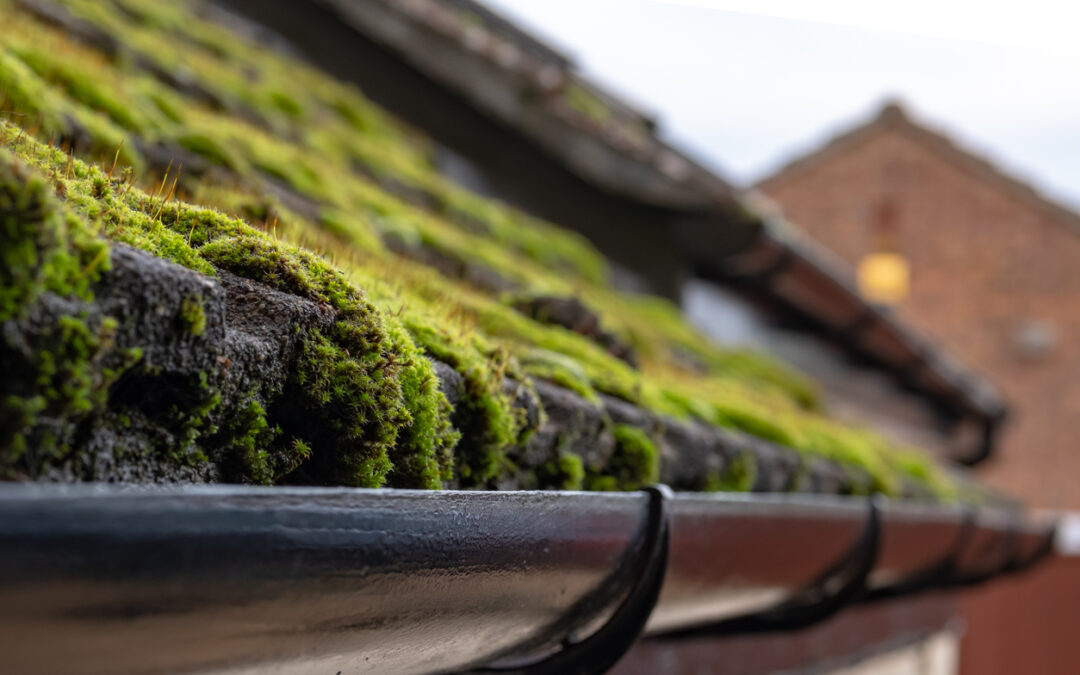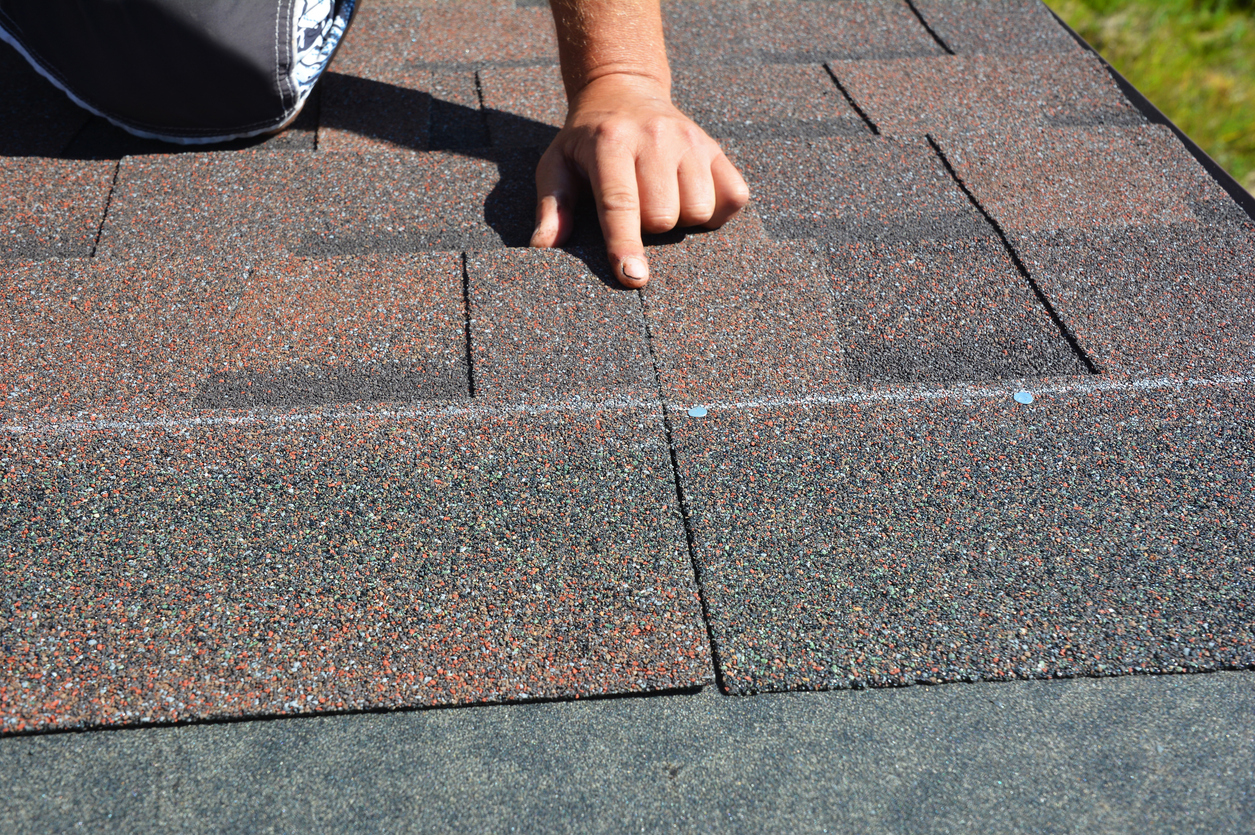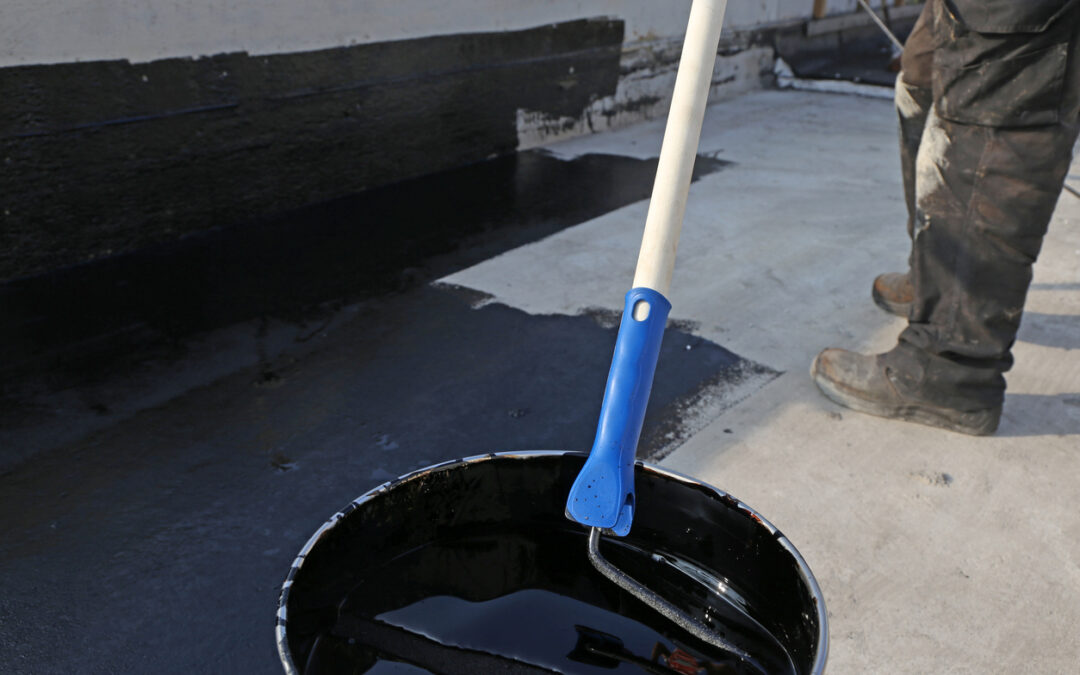
by royalcrownroofing | Jul 28, 2023 | Roof Maintenance, Roof Replacement, Roofing Materials
That beautiful moss that covers ancient English homes in old movies looks great, but if it appears on your roof, it’s a destructive menace. It can seem like a harmless aesthetic issue, but it can actually pose significant dangers to the structural integrity and lifespan of your roof. It’s especially likely to take up residence in Houston area roofs because it thrives in moist and shaded environments.
Moss holds water like a sponge, creating a damp environment on the roof surface. Over time, this constant moisture can penetrate the roof’s protective layers, leading to the deterioration of roofing materials. The moisture can seep into cracks and crevices, causing damage to the underlying structure, including the roof deck and rafters. In severe cases, it can result in rotting and weakened roof integrity.
Additionally, moss can contribute to the formation of ice dams during cold weather. Although we don’t have much of that here in southeastern Texas, when those days come to us, what happens is that ice and rain water get trapped by the moss and freeze and expand, creating ice dams along the roof’s edges. Ice dams can cause water to back up under the shingles, leading to leaks and water damage to the interior of the building.
If you choose to remove the moss yourself, follow these steps to do it safely:
- Before starting any roof cleaning, prioritize safety. Use proper protective gear, including gloves, safety goggles, and non-slip shoes. Make sure the ladder is stable and securely positioned.
- Avoid using harsh chemicals or high-pressure washing, as these can damage the roof shingles. Instead, opt for gentle cleaning methods. Start by sweeping away loose debris and moss using a soft-bristle brush or broom.
- Prepare a mixture of equal parts water and white vinegar or hydrogen peroxide. Spray the solution onto the moss-infested areas and let it sit for about 15 minutes to loosen the moss.
- After the solution has had time to work, use a soft-bristle brush to gently scrub away the moss. Start from the top of the roof and work your way down to prevent the loosened moss from sliding down and causing further damage.
- Once you have removed the moss, rinse the roof thoroughly with water to wash away any remaining debris.
- To prevent future moss growth, trim overhanging tree branches to increase sunlight exposure and airflow on the roof.
If you don’t choose to climb up on your roof and do the job yourself, Royal Crown Roofing can do it for you. And once your roof is free of moss, regular maintenance is crucial to prevent it from reestablishing itself. Periodic inspections and cleanings will ensure early detection and prevent it reestablishing itself. Contact Royal Crown Roofing for their help.

by royalcrownroofing | Jul 21, 2023 | Roof Maintenance, Roof Replacement, Roofing Materials
What kind of shingles are you looking for? Are you wanting the perfect look for the architectural style of your home? Or, are you considering some practical needs? And what about your budget? Here is a lists of the most popular types and their unique characteristics and benefits:
Asphalt shingles are the most commonly used and affordable option.
Made of a fiberglass mat coated with asphalt and mineral granules, asphalt shingles come in a wide range of colors, styles, and thicknesses. They are durable, fire-resistant, and offer good protection against weather elements. However, they may have a shorter lifespan compared to other shingle types.
Wood shingles provide a natural and rustic look to roofs.
Environmentally friendly and offer excellent insulation properties. Wood shingles can last for decades when properly maintained. However, they require regular maintenance, such as periodic staining or sealing, to prevent rotting, insect infestation, and fire hazards.
Metal shingles offer longevity and energy-efficient properties.
Typically made of steel, aluminum, or copper, metal shingles can mimic the appearance of other shingle types, such as wood or slate. Metal shingles are lightweight, durable, fire-resistant, and require minimal maintenance. They are also highly reflective, which helps reduce energy consumption by reflecting sunlight.
Slate shingles are known for their timeless beauty and exceptional durability.
Made from natural stone, slate shingles offer a distinctive, elegant appearance to roofs. Slate shingles are fire-resistant, waterproof, and can last for over a century when properly installed and maintained. However, they are heavy and require a strong roof structure to support their weight. Slate shingles are also more expensive compared to other options.
Tile shingles are popular in Mediterranean or Spanish-style architecture.
Providing a unique and aesthetically pleasing look to roofs, tile shingles are durable, fire-resistant, and can withstand harsh weather conditions. They offer excellent insulation properties and can last for several decades. However, they are heavy and require a sturdy roof structure. The installation of tile shingles can be labor-intensive and more expensive compared to other shingle types.
Composite shingles are a synthetic product.
Made of a mixture of materials, including fiberglass, recycled plastics, and asphalt, composite shingles are designed to mimic the appearance of other shingle types, such as wood or slate. Composite shingles. one of the most widely used roof coverings, are lightweight, durable, and offer good resistance against weather elements. They are typically more affordable than natural materials but may have a slightly shorter lifespan.
Royal Crown Roofing can help you decide which type of shingles you want on your roof.They can show you samples and give you estimates. Contact them for a consultation.

by royalcrownroofing | Jul 14, 2023 | Home Renovation, Roof Damage, Roof Maintenance, Roof Repair, Roofing Materials
Roof coatings offer numerous benefits, but you should look at the pros and cons before deciding to apply them. Consider the following:
Pros:
They extend the roof’s lifespan.
These coatings create a protective barrier against UV rays, extreme temperatures, and weather elements, reducing the rate of deterioration. By shielding the roof surface from damage, coatings can add several years to the roof’s lifespan.
They are energy efficient.
Roof coatings can improve a building’s energy efficiency by reflecting sunlight and reducing heat absorption. Reflective coatings help to keep the roof surface cooler, reducing the need for excessive air conditioning and lowering energy costs. This can be particularly beneficial in warmer climates like ours here in the Houston area and can contribute to overall energy savings.
They are cost-effective.
Roof coatings can be a cost-effective alternative to roof replacement. They are generally less expensive than installing a new roof and can provide similar benefits in terms of protection and energy efficiency. Coatings also require less maintenance and repair over time, resulting in additional cost savings.
They provide waterproofing and prevent leaks.
Roof coatings act as an additional waterproofing layer. They can help seal small cracks and gaps, reducing the risk of leaks and water damage. By preventing moisture infiltration, coatings can help preserve the integrity of the roof and the building as a whole.
Cons:
They are complex to apply.
Proper application of roof coatings requires skill and expertise. Improper application can result in an ineffective coating that does not provide the desired benefits. It is crucial to hire a professional roofing contractor with experience in applying roof coatings to ensure a proper and long-lasting installation.
They have a limited lifespan.
While roof coatings can extend the lifespan of a roof, it is important to note that they have a limited lifespan themselves. Coatings will eventually degrade and require reapplication. Regular maintenance and reapplication are necessary to maintain the coating’s effectiveness.
They may not be compatible with all roof types.
Compatibility issues can arise when applying certain coatings to specific roofing materials. It is crucial to consult with a professional to determine the compatibility and suitability of a particular coating for your roof type.
They require significant surface preparation.
Before applying a roof coating, the roof surface must be thoroughly cleaned and prepared. This process can be time-consuming and may require repairs or modifications to the roof structure.
Before opting for a roof coating, it is advisable to consult with a professional roofing contractor to determine the suitability and benefits of the coating for your specific roof type and needs. Contact Royal Crown Roofing and they will be glad to help you decide if roof coating is right for your roof.

by royalcrownroofing | Jul 7, 2023 | Roof Maintenance, Roof Replacement, Roofing Materials
Your flat roof, with its sleek design and cost-effectiveness, deals with a much greater accumulation of leaves, branches, dirt and other debris that need clearing off. If you feel comfortable climbing up on roofs, you might use a broom or blower to sweep it clean, but otherwise call a roofing expert like Royal Crown Roofing for their help.
You also need to deal with overhanging branches that not only deposit debris but can also scratch or puncture the roof surface during storms or high winds. Any branches that are in close proximity to your roof need to be trimmed to minimize the risk of damage.
Another problem on flat roofs is that of standing water. Effective drainage is vital for the roof’s health. Standing water which is more likely on a flat roof can cause structural damage and increase the risk of leaks, so keeping the drainage system in good working condition is essential. Clogged gutters, downspouts, and drains need continual clearing to ensure water can flow freely off the roof.
Ponding is a term that refers to the accumulation of water on the roof surface for more than 48 hours after rainfall, a dangerous situation for your roof. It can weaken its structure, lead to leaks, and accelerate deterioration.
Even a small leak can quickly escalate into a major problem if left unattended. If you notice any signs of water infiltration, such as stains on the ceiling or walls, damp spots, or musty odors, address them immediately. The leak needs to be located and sealed promptly. Ignoring leaks can result in extensive damage to the roof and the interior of the building.
Regular inspections, preferably in the spring and fall, and after severe weather events are key to identifying any signs of water damage or wear and tear early on. Cracks, blisters, pooling of water, loose seams, and any signs of deterioration need to be found early to keep your roof in good shape. This allows for timely repairs, preventing them from escalating into larger and more expensive issues.
While you may be able to handle some maintenance tasks yourself, it’s advisable to have a professional roofing contractor inspect and maintain your flat roof periodically. They have the expertise and experience to identify potential issues that you may not notice and can perform repairs or maintenance tasks correctly. Royal Crown Roofing is here to assist you in caring for your roof. Call them.






